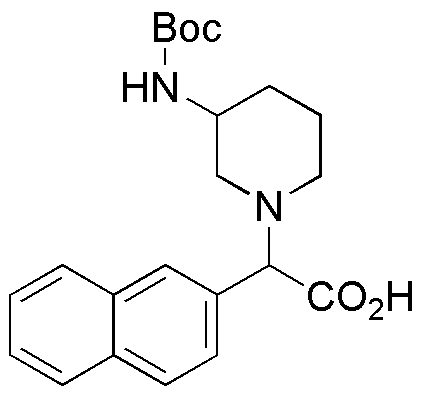(3-Boc-aminopiperidin-1-yl)naphthalen-2-yl-acetic acid is widely utilized in research focused on:
- Pharmaceutical Development: This compound serves as a key intermediate in the synthesis of various pharmaceuticals, particularly in the development of drugs targeting neurological disorders.
- Biochemical Research: It is used in studies investigating receptor interactions and signaling pathways, providing insights into cellular mechanisms and potential therapeutic targets.
- Drug Formulation: The compound's unique structure enhances solubility and bioavailability, making it valuable in formulating effective drug delivery systems.
- Material Science: Its properties allow for applications in creating advanced materials, such as polymers and coatings, which require specific chemical functionalities.
- Analytical Chemistry: This chemical acts as a standard in various analytical techniques, aiding in the development of methods for detecting and quantifying similar compounds.
General Information
Properties
Safety and Regulations
Applications
(3-Boc-aminopiperidin-1-yl)naphthalen-2-yl-acetic acid is widely utilized in research focused on:
- Pharmaceutical Development: This compound serves as a key intermediate in the synthesis of various pharmaceuticals, particularly in the development of drugs targeting neurological disorders.
- Biochemical Research: It is used in studies investigating receptor interactions and signaling pathways, providing insights into cellular mechanisms and potential therapeutic targets.
- Drug Formulation: The compound's unique structure enhances solubility and bioavailability, making it valuable in formulating effective drug delivery systems.
- Material Science: Its properties allow for applications in creating advanced materials, such as polymers and coatings, which require specific chemical functionalities.
- Analytical Chemistry: This chemical acts as a standard in various analytical techniques, aiding in the development of methods for detecting and quantifying similar compounds.
Documents
Safety Data Sheets (SDS)
The SDS provides comprehensive safety information on handling, storage, and disposal of the product.
Product Specification (PS)
The PS provides a comprehensive breakdown of the product’s properties, including chemical composition, physical state, purity, and storage requirements. It also details acceptable quality ranges and the product's intended applications.
Certificates of Analysis (COA)
Search for Certificates of Analysis (COA) by entering the products Lot Number. Lot and Batch Numbers can be found on a product’s label following the words ‘Lot’ or ‘Batch’.
*Catalog Number
*Lot Number
Certificates Of Origin (COO)
This COO confirms the country where the product was manufactured, and also details the materials and components used in it and whether it is derived from natural, synthetic, or other specific sources. This certificate may be required for customs, trade, and regulatory compliance.
*Catalog Number
*Lot Number
Safety Data Sheets (SDS)
The SDS provides comprehensive safety information on handling, storage, and disposal of the product.
DownloadProduct Specification (PS)
The PS provides a comprehensive breakdown of the product’s properties, including chemical composition, physical state, purity, and storage requirements. It also details acceptable quality ranges and the product's intended applications.
DownloadCertificates of Analysis (COA)
Search for Certificates of Analysis (COA) by entering the products Lot Number. Lot and Batch Numbers can be found on a product’s label following the words ‘Lot’ or ‘Batch’.
*Catalog Number
*Lot Number
Certificates Of Origin (COO)
This COO confirms the country where the product was manufactured, and also details the materials and components used in it and whether it is derived from natural, synthetic, or other specific sources. This certificate may be required for customs, trade, and regulatory compliance.


